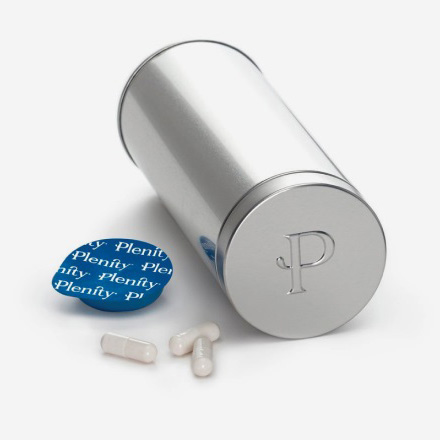Table of Contents
About Plenity

Plenity is a weight loss pill that signals to your body that it is actually more full than it is. The key is in the components of the device—each pill is made from citric acid and cellulose. In your stomach, these particles help keep you from overeating.
Plenity Ingredients
Cellulose
Cellulose is the main ingredient in Plenity—it is essentially a type of dietary fiber that is found in the cell walls of plants. Cellulose is a complex carbohydrate that cannot be digested by the human body, but it plays an important role in maintaining digestive health.
Benefits of cellulose
Promotes digestive health: As mentioned earlier, cellulose is not digested by the human body, but it does provide bulk to the stool, which helps promote regular bowel movements and prevent constipation.
Lowers cholesterol levels: Studies have shown that consuming foods high in cellulose can help reduce LDL (“bad”) cholesterol levels, which can lower the risk of heart disease.
Helps with weight management: Foods high in cellulose tend to be low in calories and can help promote feelings of fullness, which can reduce appetite and support weight management.
Supports overall health: Cellulose has antioxidant properties that can help protect against cellular damage and reduce the risk of chronic diseases, such as cancer.
How cellulose is consumed
Cellulose is found in many plant-based foods, such as fruits, vegetables, whole grains, and legumes. It is also available as a dietary supplement.
Dosage:
The recommended daily intake of cellulose varies depending on the individual’s needs and dietary habits. However, it is recommended to consume at least 25-30 grams of dietary fiber per day, with at least 7 grams coming from insoluble fiber (such as cellulose).
Side Effects:
Consuming too much cellulose can cause bloating, gas, and abdominal discomfort. It is important to increase fiber intake gradually and drink plenty of water to avoid these side effects.
Citric Acid
Citric acid is a weak organic acid found in citrus fruits, such as lemons and limes. It is commonly used as a food preservative, flavor enhancer, and cleaning agent.
Benefits of citric acid
Preserves food: Citric acid has antimicrobial properties that can help prevent the growth of bacteria and other microorganisms in food, which can help extend the shelf life of perishable products.
Enhances flavor: Citric acid has a sour taste that can enhance the flavor of foods and beverages. It is commonly used as a flavoring agent in soft drinks, candies, and other processed foods.
Cleans surface: Citric acid can be used as a cleaning agent to remove hard water stains, soap scum, and other mineral deposits from surfaces such as glass, metal, and ceramic.
Enhances absorption of nutrients: Citric acid can enhance the absorption of certain nutrients, such as iron and calcium, by chelating with them and making them more soluble and bioavailable.
How citric acid is consumed
Citric acid is found in many foods and beverages, such as citrus fruits, soft drinks, and candies. It is also available as a dietary supplement.
Dosage:
The recommended daily intake of citric acid varies depending on the individual’s needs and dietary habits. However, it is important to consume citric acid in moderation, as consuming too much can cause gastrointestinal discomfort and other health issues.
Side Effects:
Consuming too much citric acid can cause gastrointestinal discomforts, such as nausea, vomiting, and diarrhea. It can also cause tooth erosion and other dental issues when consumed in high amounts. It is important to consume citric acid in moderation and as part of a balanced diet.
How To Take Plenity

Each Plenity capsule contains thousands of superabsorbent hydrogel particles (0.75 grams [g] per capsule), and each particle is approximately the size of a grain of salt. Patients consume three (3) capsules (2.25 g/dose) with water before both lunch and dinner.
The capsules disintegrate in the stomach and release the Plenity particles, which can hydrate up to 100 times their original weight. When fully hydrated, the individual nonclustering Plenity particles occupy about a quarter of average stomach volume.
The gel particles mix with ingested foods, creating a larger volume with higher elasticity and viscosity in the stomach and small intestine, promoting satiety and fullness.
Plenity passes through the digestive system, maintaining its three-dimensional structure in the stomach and small intestine before breaking down in the colon. The water is then released and reabsorbed by the body. Plenity particles are eliminated through normal bowel movements (not absorbed).
References
1. Yan, J., et al., Innovative nanofibrillated cellulose from rice straw as dietary fiber for enhanced health benefits prepared by a green and scale production method. ACS Sustainable Chemistry & Engineering, 2018. 6(3): p. 3481-3492. https://pubs.acs.org/doi/abs/10.1021/acssuschemeng.7b03765
2. Hillman, L.C., et al., The effects of the fiber components pectin, cellulose and lignin on serum cholesterol levels. The American Journal of Clinical Nutrition, 1985. 42(2): p. 207-213. https://academic.oup.com/ajcn/article-abstract/42/2/207/4691693
3. Ratnakumar, A., et al., Cellulose microfibres from traditional rice straw: Physicochemical properties and analytical characterization. Materials Today: Proceedings, 2021. 45: p. 5714-5719. https://www.sciencedirect.com/science/article/pii/S2214785321016588
4. Carrion, C.C., et al., Lignin, lipid, protein, hyaluronic acid, starch, cellulose, gum, pectin, alginate and chitosan-based nanomaterials for cancer nanotherapy: Challenges and opportunities. International Journal of Biological Macromolecules, 2021. 178: p. 193-228. https://www.sciencedirect.com/science/article/abs/pii/S0141813021004025
5. Ciolacu, D.E., R. Nicu, and F. Ciolacu, Cellulose-based hydrogels as sustained drug-delivery systems. Materials, 2020. 13(22): p. 5270. https://www.mdpi.com/1996-1944/13/22/5270
6. Suttirak, W. and S. Manurakchinakorn, Potential application of ascorbic acid, citric acid and oxalic acid for browning inhibition in fresh-cut fruits and vegetables. Walailak Journal of Science and Technology (WJST), 2010. 7(1): p. 5-14. https://wjst.wu.ac.th/index.php/wjst/article/view/47
7. De’Nobili, M.D., et al., Stability of L-(+)-ascorbic acid in alginate edible films loaded with citric acid for antioxidant food preservation. Journal of Food Engineering, 2016. 175: p. 1-7. https://www.sciencedirect.com/science/article/abs/pii/S0260877415300625
8. Low, M.Y., et al., Effect of citric acid and glycine addition on acrylamide and flavor in a potato model system. Journal of Agricultural and Food Chemistry, 2006. 54(16): p. 5976-5983. https://pubs.acs.org/doi/abs/10.1021/jf060328x
9. Altundoğan, H.S., et al., Hardness removal from waters by using citric acid modified pine cone. Journal of the Taiwan Institute of Chemical Engineers, 2016. 58: p. 219-225. https://www.sciencedirect.com/science/article/abs/pii/S1876107015003284
10. Hallberg, L. and L. Rossander, Improvement of iron nutrition in developing countries: Comparison of adding meat, soy protein, ascorbic acid, citric acid, and ferrous sulphate on iron absorption from a simple Latin American-type of meal. The American Journal of Clinical Nutrition, 1984. 39(4): p. 577-583. https://academic.oup.com/ajcn/article-abstract/39/4/577/4691185
11. Femiano, F., et al., A comparison of salivary substitutes versus a natural sialogogue (citric acid) in patients complaining of dry mouth as an adverse drug reaction: A clinical, randomized controlled study. Oral Surgery, Oral Medicine, Oral Pathology, Oral Radiology, and Endodontology, 2011. 112(1): p. e15-e20. https://www.sciencedirect.com/science/article/abs/pii/S1079210411000667
You might also be interested in articles on Relief Factor Ingredients or FLO Gummies Ingredients.

Leave a Reply